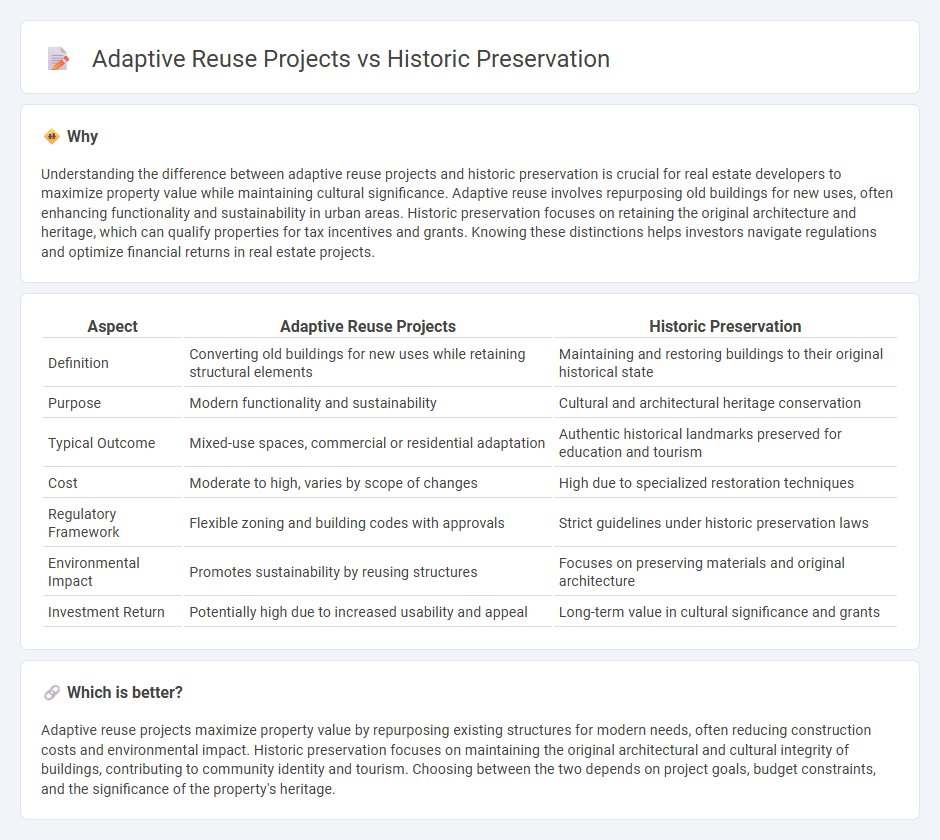
Adaptive reuse projects transform obsolete buildings into functional spaces, enhancing sustainability and urban revitalization. Historic preservation focuses on maintaining the original architectural integrity to protect cultural heritage. Explore more about how these approaches impact property value and community development.
Why it is important
Understanding the difference between adaptive reuse projects and historic preservation is crucial for real estate developers to maximize property value while maintaining cultural significance. Adaptive reuse involves repurposing old buildings for new uses, often enhancing functionality and sustainability in urban areas. Historic preservation focuses on retaining the original architecture and heritage, which can qualify properties for tax incentives and grants. Knowing these distinctions helps investors navigate regulations and optimize financial returns in real estate projects.
Comparison Table
| Aspect | Adaptive Reuse Projects | Historic Preservation |
|---|---|---|
| Definition | Converting old buildings for new uses while retaining structural elements | Maintaining and restoring buildings to their original historical state |
| Purpose | Modern functionality and sustainability | Cultural and architectural heritage conservation |
| Typical Outcome | Mixed-use spaces, commercial or residential adaptation | Authentic historical landmarks preserved for education and tourism |
| Cost | Moderate to high, varies by scope of changes | High due to specialized restoration techniques |
| Regulatory Framework | Flexible zoning and building codes with approvals | Strict guidelines under historic preservation laws |
| Environmental Impact | Promotes sustainability by reusing structures | Focuses on preserving materials and original architecture |
| Investment Return | Potentially high due to increased usability and appeal | Long-term value in cultural significance and grants |
Which is better?
Adaptive reuse projects maximize property value by repurposing existing structures for modern needs, often reducing construction costs and environmental impact. Historic preservation focuses on maintaining the original architectural and cultural integrity of buildings, contributing to community identity and tourism. Choosing between the two depends on project goals, budget constraints, and the significance of the property's heritage.
Connection
Adaptive reuse projects transform historic buildings by preserving architectural heritage while repurposing structures for modern real estate needs, enhancing cultural value and sustainability. Historic preservation standards guide these projects, ensuring authenticity and compliance with regulations that protect landmark status. This synergy boosts property values and promotes community revitalization through the conservation of historically significant sites.
Key Terms
Conservation
Historic preservation prioritizes maintaining the original materials, architectural integrity, and cultural significance of heritage buildings to safeguard their authenticity. Adaptive reuse projects focus on repurposing historic structures for new functions while respecting key conservation principles, ensuring environmental sustainability and historical context are preserved. Explore further to understand how conservation strategies balance heritage value with modern usability in these transformative projects.
Repurposing
Historic preservation protects and maintains the original features and architectural integrity of significant buildings, ensuring cultural heritage remains intact for future generations. Adaptive reuse involves transforming historic structures for new purposes, balancing conservation with practicality to meet contemporary needs while reducing environmental impact. Explore the benefits and strategies of repurposing historic sites to enhance sustainable urban development and cultural continuity.
Rehabilitation
Rehabilitation in historic preservation emphasizes repairing and altering a building to meet contemporary needs while retaining its historic character and materials, ensuring structural safety and functionality without compromising heritage value. Adaptive reuse projects often involve repurposing historic structures for new uses, blending preservation with innovation to extend the building's lifecycle and sustainability. Discover how rehabilitation techniques balance maintaining authenticity with modern demands to preserve cultural landmarks effectively.
Source and External Links
Historic Preservation | Bismarck, ND - Official Website - Historic preservation in Bismarck focuses on conserving the city's heritage by protecting buildings, objects, and sites of historical and cultural significance, managed by the local Historic Preservation Commission, which also promotes public education and maintains the city's historic districts.
Historic preservation - Wikipedia - Historic preservation is the effort to protect and conserve buildings, landscapes, and artifacts of historical importance, rooted in the 20th-century philosophy that cities should safeguard their patrimonial legacy, with key milestones including early local ordinances and the growth of organizations like the National Trust for Historic Preservation.
What is Historic Preservation? - National Park Service - Historic preservation is a dynamic process that connects past and future, supported by federal programs like tax incentives for rehabilitating historic buildings, which drive community revitalization and private investment across the United States.
 dowidth.com
dowidth.com